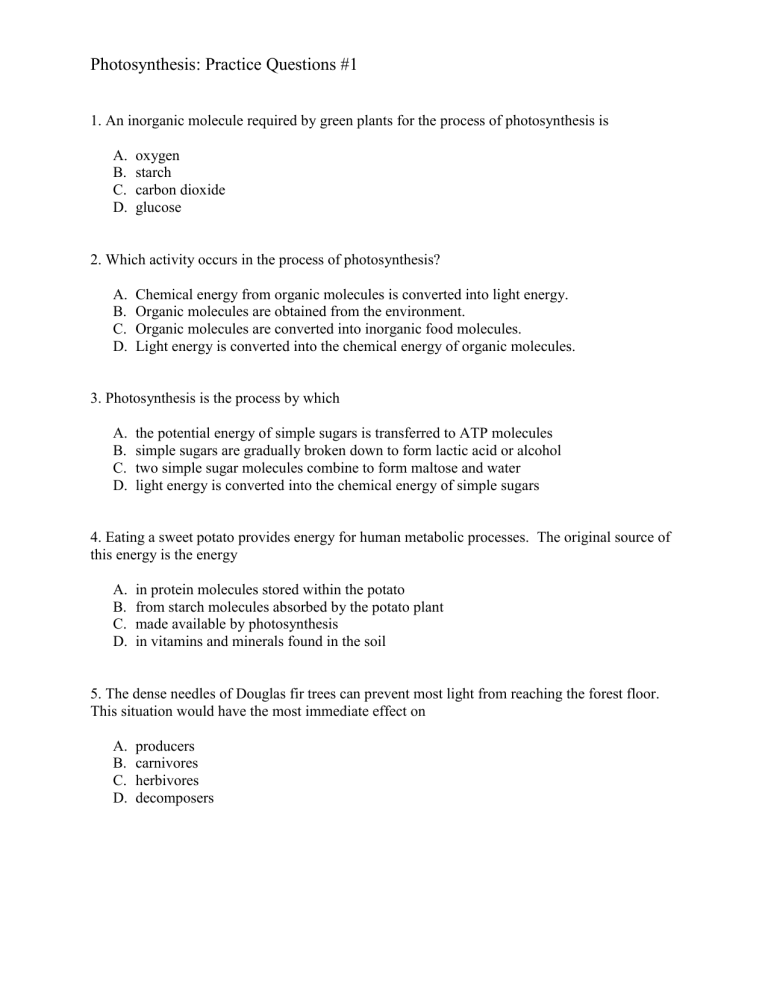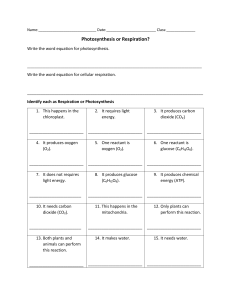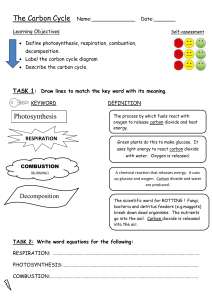
Photosynthesis: Practice Questions #1 1. An inorganic molecule required by green plants for the process of photosynthesis is A. B. C. D. oxygen starch carbon dioxide glucose 2. Which activity occurs in the process of photosynthesis? A. B. C. D. Chemical energy from organic molecules is converted into light energy. Organic molecules are obtained from the environment. Organic molecules are converted into inorganic food molecules. Light energy is converted into the chemical energy of organic molecules. 3. Photosynthesis is the process by which A. B. C. D. the potential energy of simple sugars is transferred to ATP molecules simple sugars are gradually broken down to form lactic acid or alcohol two simple sugar molecules combine to form maltose and water light energy is converted into the chemical energy of simple sugars 4. Eating a sweet potato provides energy for human metabolic processes. The original source of this energy is the energy A. B. C. D. in protein molecules stored within the potato from starch molecules absorbed by the potato plant made available by photosynthesis in vitamins and minerals found in the soil 5. The dense needles of Douglas fir trees can prevent most light from reaching the forest floor. This situation would have the most immediate effect on A. B. C. D. producers carnivores herbivores decomposers 6. The diagram represents part of a life process in a leaf chloroplast. If the process illustrated in the diagram is interrupted by a chemical at point X, there would be an immediate effect on the release of A. B. C. D. chlorophyll nitrogen carbon dioxide oxygen 7. The equation below represents a summary of a biological process. carbon dioxide + water → glucose + water + oxygen This process is completed in A. B. C. D. mitochondria ribosomes cell membranes chloroplasts 8. Which process is directly used by autotrophs to store energy in glucose? A. B. C. D. diffusion photosynthesis respiration active transport 9. Organisms that have the ability to use an atmospheric gas to produce an organic nutrient are known as A. B. C. D. herbivores decomposers carnivores autotrophs 10. Leaves of green plants contain openings known as stomates, which are opened and closed by specialized cells allowing for gas exchange between the leaf and the outside environment. Which phrase best represents the net flow of gases involved in photosynthesis into and out of the leaf through these openings on a sunny day? A. B. C. D. carbon dioxide moves in; oxygen moves out carbon dioxide and oxygen move in; ozone moves out oxygen moves in; nitrogen moves out water and ozone move in; carbon dioxide moves out 11. Which process usually uses carbon dioxide molecules? A. B. C. D. cellular respiration asexual reproduction active transport autotrophic nutrition 12. The green aquatic plant represented in the diagram below was exposed to light for several hours. Which gas would most likely be found in the greatest amount in the bubbles? A. B. C. D. oxygen nitrogen ozone carbon dioxide 13. The diagram below illustrates the movement of materials involved in a process that is vital for the energy needs of organisms. The process illustrated occurs within A. B. C. D. chloroplasts mitochondria ribosomes vacuoles 14. For which organic compounds must information be encoded in DNA for green plants to synthesize the other three compounds? A. B. C. D. sugars starches fats proteins 15. Which statement describes all enzymes? A. B. C. D. They control the transport of materials. They provide energy for chemical reactions. They affect the rate of chemical reactions. They absorb oxygen from the environment. 16. The photograph below shows a microscopic view of the lower surface of a leaf. What is the main function of the cells indicated by the black pointer? A. B. C. D. regulate the rate of gas exchange store food for winter dormancy undergo mitotic cell division give support to the veins in the leaf 17. The dissolved carbon dioxide in a lake is used directly by A. B. C. D. autotrophs parasites fungi decomposers 18. Which process illustrates a feedback mechanism in plants? A. B. C. D. Chloroplasts take in more nitrogen, which increases the rate of photosynthesis. Chloroplasts release more oxygen in response to a decreased rate of photosynthesis. Guard cells change the size of leaf openings, regulating the exchange of gases. Guard cells release oxygen from the leaf at night. 19. An enzyme known as rubisco enables plants to use large amounts of carbon dioxide. This enzyme is most likely active in the A. B. C. D. nucleus vacuoles mitochondria chloroplasts 20. Starch molecules present in a maple tree are made from materials that originally entered the tree from the external environment as A. B. C. D. enzymes simple sugars amino acids inorganic compounds 21. The diagram below represents events associated with a biochemical process that occurs in some organisms. Which statement concerning this process is correct? A. The process represented is respiration and the primary source of energy for the process is the Sun. B. The process represented is photosynthesis and the primary source of energy for the process is the Sun. C. This process converts energy in organic compounds into solar energy which is released into the atmosphere. D. This process uses solar energy to convert oxygen into carbon dioxide. 22. In the transfer of energy from the Sun to ecosystems, which molecule is one of the first to store this energy? A. B. C. D. protein fat DNA glucose 23. The diagram below represents a cross section of part of a leaf. Which life functions are directly regulated through feedback mechanisms associated with the actions of the structures labeled X? A. B. C. D. excretion and immunity digestion and coordination circulation and reproduction respiration and photosynthesis 24. The diagram below represents a biological process. Which set of molecules is best represented by letters A and B? A. A: oxygen and water B: glucose B. A: glucose B: carbon dioxide and water C. A: carbon dioxide and water B: glucose D. A: glucose B: oxygen and water 25. A green plant is kept in a brightly lighted area for 48 hours. What will most likely occur if the light intensity is then reduced slightly during the next 48 hours? A. B. C. D. Photosynthesis will stop completely. The rate at which nitrogen is used by the plant will increase. The rate at which oxygen is released from the plant will decrease. Glucose production inside each plant cell will increa 26. If the leaves of a geranium plant receive an adequate supply of raw materials, which graph below shows how the rate of photosynthesis is related to increasing light intensity received by the plant? A. B. C. D. 27. An organism was added to a test tube containing water, which was then sealed and placed in sunlight. The graph shows an increase in the oxygen content of the test tube over a period of time. Which type of organism was most probably added to the test tube? A. B. C. D. fresh-water animal green alga ameba virus 28. Much of the carbon dioxide produced by algae is not excreted as a metabolic waste because it A. B. C. D. can be used for photosynthesis cannot pass through cell membranes is needed for aerobic respiration is used for the hydrolysis of proteins 29. Most of the oxygen gas present in the atmosphere is produced as a result of A. B. C. D. photosynthesis cellular respiration dehydration synthesis decomposition 30. Which biological process is the main source of atmospheric oxygen? A. B. C. D. respiration photosynthesis hydrolysis synthesis 31. The graph represents the absorption spectrum of chlorophyll. The graph indicates that the energy used in photosynthesis is most likely obtained from which regions of the spectrum? A. B. C. D. yellow and orange red violet blue and green orange red and violet blue green and yellow 32. The mass of some corn plants at the end of their growth period was 6 tons per acre. Most of this mass was produced from A. B. C. D. water and organic compounds absorbed from the soil minerals from the soil and oxygen from the air minerals and organic materials absorbed from the soil water from the soil and carbon dioxide from the air 33. The graph below shows the results of an experiment in which a container of oxygen-using bacteria and strands of a green alga were exposed to light of different colors. Which statement best explains the results of this experiment? A. B. C. D. The rate of photosynthesis is affected by variations in the light. In all environments light is a vital resource. The activities of bacteria and algae are not related. Uneven numbers and types of species can upset ecosystem stability. 34. Which set of terms best identifies the letters in the diagram below? A. B. C. D. A B C photosynthesis inorganic molecules decomposition respiration organic molecules digestion photosynthesis organic molecules respiration respiration inorganic molecules photosynthesis 35. Base your answer to the question on the information and diagram below and on your knowledge of biology. A small water plant (elodea) was placed in bright sunlight for five hours as indicated below. Bubbles of oxygen gas were observed being released from the plant Since oxygen gas is being released, it can be inferred that the plant is A. B. C. D. producing glucose making protein releasing energy from water carrying on active transport 36. Base your answer to the question on the information and diagram below and on your knowledge of biology. A small water plant (elodea) was placed in bright sunlight for five hours as indicated below. Bubbles of oxygen gas were observed being released from the plant. What substance did the plant most likely absorb from the water for the process that produces the oxygen gas? A. B. C. D. dissolved nitrogen carbon dioxide an enzyme a hormone 37. The diagram below represents an autotrophic cell. For the process of autotrophic nutrition, the arrow labeled A would most likely represent the direction of movement of A. B. C. D. carbon dioxide, water, and solar energy oxygen, glucose, and solar energy carbon dioxide, oxygen, and heat energy glucose, water, and heat energy 38. Carbon dioxide makes up less than 1 percent of Earth’s atmosphere, and oxygen makes up about 20 percent. These percentages are maintained most directly by A. B. C. D. respiration and photosynthesis the ozone shield synthesis and digestion energy recycling in ecosystems 39. In the leaf of a plant, guard cells help to A. B. C. D. destroy atmospheric pollutants when they enter the plant regulate oxygen and carbon dioxide levels transport excess glucose to the roots block harmful ultraviolet rays that can disrupt chlorophyll production 40. Which statement best describes the starch content of two leaves taken from the same plant shown in the chart below? A. B. C. D. Neither leaf contains starch. Both leaves contain the same amount of starch. Leaf A contains more starch than leaf B. Leaf B contains more starch than leaf A. 41. The diagram below represents a process that occurs in a structure of a specialized cell. Which row in the chart correctly identifies the letters in the diagram? Row A B oxygen C D A. ribosome carbon dioxide water B. mitochondrion water oxygen protein C. nucleus nitrogen carbon starch D. chloroplast carbon dioxide water glucose 42. Which phrase, if placed in box X, would correctly complete the flowchart shown below? A. B. C. D. Increased use of starch in root cells Increased concentration of glucose in leaf cells Decreased ATP in root cells Decreased concentration of oxygen in leaf cells 43. The leaves of a plant are dotted with openings known as stomata. When open, stomata allow the plant to exchange gases and allow moisture to evaporate, helping to draw water from the roots up into the plant. These activities help the plant to A. B. C. D. produce light energy maintain homeostasis decompose organic matter synthesize minerals 44. Certain organisms are able to store energy from the Sun in energy-rich compounds. Which event best illustrates this activity? A. B. C. D. A fox captures and eats a young rabbit. A caterpillar is eaten by a blackbird. Lettuce produces organic substances. Bacteria change organic material into simple nutrients. 45. The diagram below represents a cross section of a leaf of a green plant, showing an opening (stomate) in the lower surface. A stomate in the lower surface of the leaf has a function most similar to the function of which cell structure? A. B. C. D. cell membrane vacuole ribosome nucleus 46. A biological process that occurs in plants is represented below. Which row in the chart below identifies the lettered substances in this process? Row A. B. C. D. A B C D carbon enzymes oxygen glucose dioxide carbon glucose oxygen enzymes dioxide carbon glucose enzymes oxygen dioxide carbon oxygen glucose enzymes dioxide 47. Which phrase is an example of autotrophic nutrition? A. B. C. D. a cow eating grass in a field a mushroom digesting a dead log an apple tree making its own food a tapeworm feeding in the body of a dog 48. The arrows in the diagram below represent the movement of materials. This movement of materials indicated by the arrows is most directly involved in the processes of A. B. C. D. respiration and replication photosynthesis and excretion digestion and recycling circulation and coordination 49. The diagram below represents a cell of a green plant. Solar energy is used to produce energy-rich compounds in structure A. B. C. D. A B C D 50. Scientists studying ocean organisms are discovering new and unusual species. Which observation could be used to determine that an ocean organism carries out autotrophic nutrition? A. B. C. D. Chloroplasts are visible inside the cells. Digestive organs are visible upon dissection. The organism lives close to the surface. The organism synthesizes enzymes to digest food. Answer Key 1. C 2. D 3. D 4. C 5. A 6. D 7. D 8. B 9. D 10. A 11. D 12. A 13. A 14. D 15. C 16. A 17. A 18. C 19. D 20. D 21. B 22. D 23. D 24. C 25. C 26. 27. 28. 29. 30. 31. 32. 33. 34. 35. 36. 37. 38. 39. 40. 41. 42. 43. 44. 45. 46. 47. 48. 49. 50. C B A A B C D A C A B A A B D D B B C A B C B D A




